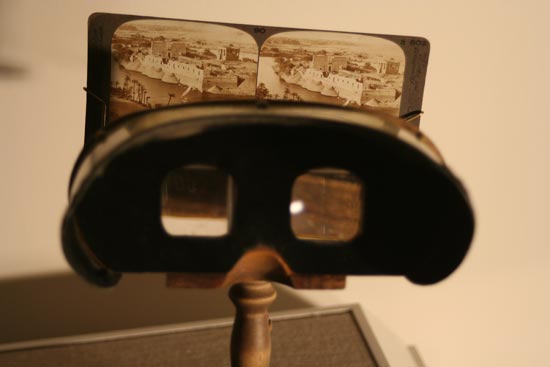STEREO VIEWERS FOR EDUCATION

Click on objects on the picture to see larger images
Before the advent of cinema and Thomas Edison's 35 mm film camera, many people experimented with creating illusions through images and photography. Pre-cinematic equipment included stereoscopic viewers and views, which took two simultaneous images of a subject from slightly different angles. When viewed through a stereoscopic viewer, the image appeared three-dimensional.
The technological development of three-dimensional photography was also a social innovation. The new ability to share visual experiences gave rise to mid-19th-century viewing parties. Guests at these social gatherings would pass around individual stereo viewers, which permitted them to gaze at distant lands, unique botany, or even art.
Kelsey envisioned another application for these viewers well beyond parlor parties. He harnessed this technology to serve the purposes of education. Reportedly, Kelsey used a larger stereo viewer that allowed students to view stereo cards of archaeological excavations. Perhaps his was an earlier projector model (stereopticon), or perhaps it was self-illuminated like the one here. During this time of rapid innovation, many variations of stereo viewers, opticons, and projectors were patented. Because of this variety the terms are sometimes used inconsistently.
Images for these devices were created on stereo optic cameras, which have two lenses placed slightly apart to mimic the placement of the human eye. Although the images on the stereo cards looked the same without a viewer, when examined through the special prismatic lens, they blended together as they would in three-dimensional eyesight. This fooled the brain into seeing two dimensions in more depth. Stereo cards were popular for 70 years, but new technologies like radio and cinema decreased demand for them in the 1920s.
-

Le Taxiphote (stereoscope viewer) with internal glass views. Wood, metal, glass, 1900–1915, Jules Richard, Paris, France Lent by Detroit Historical Society, 1966.305.001
The Taxiphote was one of many stereo viewers popular in the late 19th and early 20th century for teaching as well as for general entertainment. The device allowed users to peer inside and see views of far-away lands in three dimensions. Slides, either on paper or, as with the Taxiphote, on glass, were sold in sales catalogues. Sets of views were sold depicting sites in Italy, the Holy Land, Egypt, Greece, and other locations.
-

1896 Edison Vitascope Projection
-

Stereoscopic viewer. Wood, metal, glass Lent by George Eastman House, Rochester, NY
-

Stereoscopic views in Palestine. Paper, emulsion; part I and II box. 1990-1910?, Underwood and Underwood, New York, NY Kelsey Museum Archives
-

1910 Ingento Stereopticon Photography Catalog advertisement
-

1920s stereopticon advertisement
-

1909 Little Buckeye Post Card Projector advertisement
-

Exhibition activity table
Click on the picture to enlarge